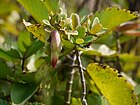Note: This is a project under development. The articles on this wiki are just being initiated and broadly incomplete. You can Help creating new pages.
Difference between revisions of "Kalanchoe pinnata"
| Line 1: | Line 1: | ||
[[File:Bryophyllum pinnatum 01.JPG|thumb|right]] | [[File:Bryophyllum pinnatum 01.JPG|thumb|right]] | ||
| + | '''Kalanchoe pinnata''' is an erect, evergreen, usually unbranched, smooth, succulent herb. It can grow up to 200cm tall. The stems usually become more or less woody, especially near the base. Plants can become more or less leafless when flowering. The plant has a wide range of medicinal uses and is often harvested from the wild. It is commonly grown as an ornamental in the tropics, and as a houseplant in colder areas. | ||
==Uses== | ==Uses== | ||
| − | {{Uses|}}, {{Uses|}}, {{Uses|}}, {{Uses|}}, {{Uses|}}, {{Uses|}}, {{Uses|}}, {{Uses| | + | {{Uses|Insect bites}}, {{Uses|Bilious diarrhoea}}, {{Uses|Diarrhoea}}, {{Uses|Dysentery}}, {{Uses|Cholera}}, {{Uses|Acute nephritis}}, {{Uses|Lithiasis}}, {{Uses|Phthisis}}.<ref name="Uses"/> |
==Parts Used== | ==Parts Used== | ||
| − | {{Parts Used| | + | {{Parts Used|Leaves}}. |
==Chemical Composition== | ==Chemical Composition== | ||
| Line 28: | Line 29: | ||
==Habit== | ==Habit== | ||
| − | {{Habit|}} | + | {{Habit|Evergreen perennial}} |
==Identification== | ==Identification== | ||
| Line 47: | Line 48: | ||
==Mode of Propagation== | ==Mode of Propagation== | ||
| − | {{Propagation|}} | + | {{Propagation|Leaves}} |
==How to plant/cultivate== | ==How to plant/cultivate== | ||
| − | <ref name="How to plant/cultivate"/> | + | Prefers a sunny position but tolerant of some shade. Tolerant of a wide range of soils and conditions.<ref name="How to plant/cultivate"/> |
==Commonly seen growing in areas== | ==Commonly seen growing in areas== | ||
| − | {{Commonly seen|}}, {{Commonly seen|}}, {{Commonly seen| | + | {{Commonly seen|Open settled areas}}, {{Commonly seen|Dry second-growth forests}}, {{Commonly seen|Roadsides}}. |
==Photo Gallery== | ==Photo Gallery== | ||
| Line 67: | Line 68: | ||
<references> | <references> | ||
| − | <ref name="chemical composition">[ | + | <ref name="chemical composition">[Chemistry]</ref> |
| − | <ref name="Leaf">[ | + | <ref name="Leaf">[Morphology]</ref> |
| − | <ref name="How to plant/cultivate">[ | + | <ref name="How to plant/cultivate">[http://tropical.theferns.info/viewtropical.php?id=Kalanchoe+pinnata Cultivation]</ref> |
<ref name="Uses">Indian Medicinal Plants by C.P.Khare</ref> | <ref name="Uses">Indian Medicinal Plants by C.P.Khare</ref> | ||
</references> | </references> | ||
==External Links== | ==External Links== | ||
| − | * [ ] | + | * [https://www.cabi.org/isc/datasheet/29328 Kalanchoe pinnata on cabi.org] |
| − | * [ ] | + | * [https://herbpathy.com/Uses-and-Benefits-of-Kalanchoe-Pinnata-Cid1161 Kalanchoe pinnata on herbpathy.com] |
| − | + | ||
[[Category:Herbs]] | [[Category:Herbs]] | ||
[[Category:Pages without herbs images]] | [[Category:Pages without herbs images]] | ||
Latest revision as of 16:25, 28 May 2020
Kalanchoe pinnata is an erect, evergreen, usually unbranched, smooth, succulent herb. It can grow up to 200cm tall. The stems usually become more or less woody, especially near the base. Plants can become more or less leafless when flowering. The plant has a wide range of medicinal uses and is often harvested from the wild. It is commonly grown as an ornamental in the tropics, and as a houseplant in colder areas.
Contents
- 1 Uses
- 2 Parts Used
- 3 Chemical Composition
- 4 Common names
- 5 Properties
- 6 Habit
- 7 Identification
- 8 List of Ayurvedic medicine in which the herb is used
- 9 Where to get the saplings
- 10 Mode of Propagation
- 11 How to plant/cultivate
- 12 Commonly seen growing in areas
- 13 Photo Gallery
- 14 References
- 15 External Links
Uses
Insect bites, Bilious diarrhoea, Diarrhoea, Dysentery, Cholera, Acute nephritis, Lithiasis, Phthisis.[1]
Parts Used
Chemical Composition
Common names
| Language | Common name |
|---|---|
| Kannada | |
| Hindi | |
| Malayalam | |
| Tamil | |
| Telugu | |
| Marathi | |
| Gujarathi | |
| Punjabi | |
| Kashmiri | |
| Sanskrit | |
| English |
Properties
Reference: Dravya - Substance, Rasa - Taste, Guna - Qualities, Veerya - Potency, Vipaka - Post-digesion effect, Karma - Pharmacological activity, Prabhava - Therepeutics.
Dravya
Rasa
Guna
Veerya
Vipaka
Karma
Prabhava
Habit
Identification
Leaf
| Kind | Shape | Feature |
|---|---|---|
Flower
| Type | Size | Color and composition | Stamen | More information |
|---|---|---|---|---|
| {{{5}}} |
Fruit
| Type | Size | Mass | Appearance | Seeds | More information |
|---|---|---|---|---|---|
Other features
List of Ayurvedic medicine in which the herb is used
Where to get the saplings
Mode of Propagation
How to plant/cultivate
Prefers a sunny position but tolerant of some shade. Tolerant of a wide range of soils and conditions.[4]
Commonly seen growing in areas
Open settled areas, Dry second-growth forests, Roadsides.
Photo Gallery
References
- ↑ Indian Medicinal Plants by C.P.Khare
- ↑ [Chemistry]
- ↑ [Morphology]
- ↑ Cultivation
External Links
- Ayurvedic Herbs known to be helpful to treat Insect bites
- Ayurvedic Herbs known to be helpful to treat Bilious diarrhoea
- Ayurvedic Herbs known to be helpful to treat Diarrhoea
- Ayurvedic Herbs known to be helpful to treat Dysentery
- Ayurvedic Herbs known to be helpful to treat Cholera
- Ayurvedic Herbs known to be helpful to treat Acute nephritis
- Ayurvedic Herbs known to be helpful to treat Lithiasis
- Ayurvedic Herbs known to be helpful to treat Phthisis
- Herbs with Leaves used in medicine
- Habit - Evergreen perennial
- Index of Plants which can be propagated by Leaves
- Herbs that are commonly seen in the region of Open settled areas
- Herbs that are commonly seen in the region of Dry second-growth forests
- Herbs that are commonly seen in the region of Roadsides
- Herbs
- Pages without herbs images





